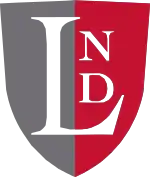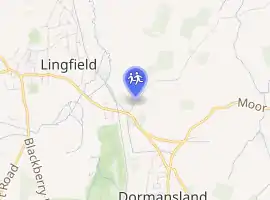Lingfield College
Lingfield College is an independent school situated in the English county of Surrey, for pupils aged from two to eighteen. It is co-educational and in total has approximately 940 pupils, spread over two sites situated next to one another: the Prep School (catering for the two to eleven-year-old pupils); and the Senior School (catering for the School's eleven- to eighteen-year-old pupils).
| Lingfield College | |
|---|---|
 | |
| Location | |

| |
| , , RH7 6PH United Kingdom | |
| Coordinates | 51°10′18″N 0°00′04″E |
| Information | |
| Type | Independent Day School |
| Religious affiliation(s) | Non-Denominational Christian |
| Established | 1940 |
| Local authority | Surrey County Council |
| Department for Education URN | 125387 Tables |
| Gender | Co-educational |
| Age | 2 to 18 |
| Enrolment | Approx. 940 |
| Colour(s) | Cherry and grey |
| Publication | Lingfield Review |
| Website | www.lingfieldcollege.co.uk |
History
Lingfield College was founded in 1940 by three members of the Roman Catholic School Sisters of Notre Dame as an all-girls school. They had arrived from Faversham, Kent with fourteen young evacuees and set up a school. The School originally occupied houses in Lingfield, before the purchase of Batnors Hall (the current site of the Prep School) and Ivy House (the current site of the Senior School), both on the edge of the village, and close by to Lingfield Racecourse. Ivy House was renamed Le Clerc House, after Alix Le Clerc, the founder of the sixteenth-century order from which the Sisters' congregation was descended.
The School was expanded over both sites in the 1950s and 1960s; however by the early 1980s, a decline in vocations made the Sisters feel the need to focus their now more limited resources elsewhere in the world. They left Lingfield in 1986. The School's governance was turned over to a lay educational trust, after which boarding was discontinued and lay senior staff and a board of governors were appointed to replace the Sisters. In 1996 the school became fully co-educational, after the appointment of Nuala Shepley as Head Mistress in 1992.
The 1990s and 2000s saw the rapid construction of further classrooms, Science laboratories, a Music/Drama block, Sports Hall, an Art/Technology block, and the development of further playing fields on former farmland adjacent to the Senior School. The old gymnasium was converted to a dining hall and kitchens, the School Library was enlarged, the Home Economics room was updated, and a new VI Form Centre was built to cater for the growing numbers of pupils. A new cricket pavilion and an Astroturf surface were built, and in 2008, the main Senior School building was refurbished, a separate dining room was created in the expanded VI Form Centre and the Fitness Suite at the Sports Hall was expanded.
Likewise, the Prep School saw similar development with the building of a new Assembly Hall/Sports Hall, further classrooms, a Science laboratory, dining hall, and staff offices. The playground area was enlarged, the former dining room was converted into a hall with a Drama facility and Art Department, car parks were added, and the Nursery and Foundation Departments were refurbished and expanded.
In 2005, the School Governors agreed to an enlarged intake at Year Nine (13+) which increased the total school roll to around 820 pupils by 2010. In Summer 2011, Nuala Shepley retired and Richard Bool (formerly of Ardingly College and Sherborne) was appointed as the new Head Master.
Lingfield confirmed the opening of a new State-of-the-Art Sixth Form Centre for the 2014/15 academic year. This concluded a three-year design and construction project, the largest in the school's history. The new building encompasses a statement central atrium, 150-seater university-style lecture theatre, Apple media suite, careers suite, 6 specialist teaching rooms, modern common room, study zones and a coffee shop. Recently there has been a further Science Laboratory built and flood lights added to the Astroturf. The School also completed building a new Music Centre in 2017.
School System
The School is divided into two physical sites (located next to one another): the Prep School (location of pupils from Nursery to Year Six); and the Senior School (location of pupils Year Seven to Sixth Form). In the Prep School each year contains approximately forty pupils in two forms. In Years Seven and Eight, the year size is increased to approximately eighty pupils in four forms. There is a further intake at 13+ and the Sixth Form.
It is usual for most pupils from the Prep School to continue to the Senior School. An entrance exam for 11+ and 13+ is held in January which is taken by outside students, with only the top-scoring selected to join the school.
Academic, Art, Sport, Music and Drama scholarships, as well as bursaries are available.
Pupils in the Senior School study English, Maths, Science, Geography, History, Philosophy and Religion, Drama, Music, Computer Science, French, and either Spanish or German (from Year Seven onwards).[1] Over 160 extra-curricular clubs are offered,[2] and sports afternoons are allocated to the various year groups. Fixtures are played against other independent and state schools on these afternoons and on Saturdays.
GCSE, iGCSE and A-Level
At GCSE or iGCSE (Year Ten and Eleven), most students normally take seven compulsory subjects: Maths, English Literature, English Language, Biology, Chemistry, Physics and one modern foreign language; and choose three further options from a choice of the following: Art, Computer Science, Drama, Economics, Geography, History, Music, a second foreign language, Media Studies, Philosophy and Religion, Physical Education (PE) and Home Economics. The School enters students for the new IGCSE qualification. Those considered good enough at Maths are offered the chance to take a further qualification.
There are a 163 students in the Sixth Form: seventy six in the Lower Sixth (Year 12) and eighty seven in the Upper Sixth (Year 13). It is usual for sixth formers to take four subjects for AS level and to continue with three for A2 level, although there are some exceptions to this each year. In addition to the subjects taught at GCSE level, Further Maths, Media Studies, Business Studies, Photography and Psychology are offered at A-Level.[3]
House System
Lingfield has four Houses; Bell, Yeates, Clubb and Higgins named after the parents that took the school from the Notre Dame Sisters. These were originally named after St Andrew, St Patrick, St David and St George. The pupils are assigned to a house to give a boarding school feel for the pupils and under the supervision of a member of staff acting as a head-of-house, the houses compete in sport, music and charitable fundraising events throughout the year.
- Bell House
- Yeates House
- Clubb House
- Higgins House
References
External links
- School website
- ISI Report 2017
- Profile on the Independent Schools Council website
- Overview on the Charities Commission website
